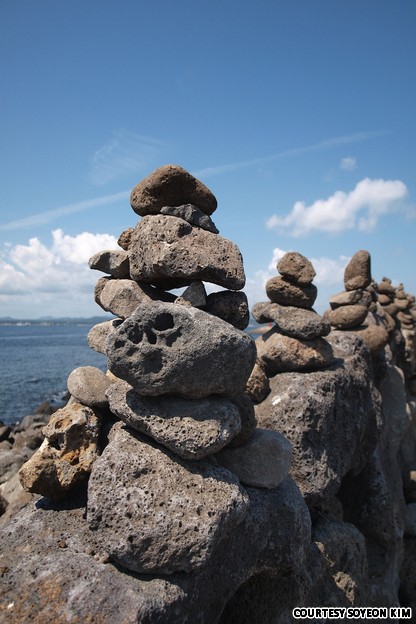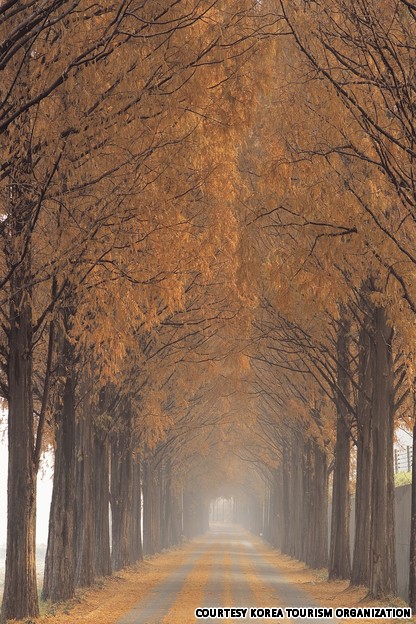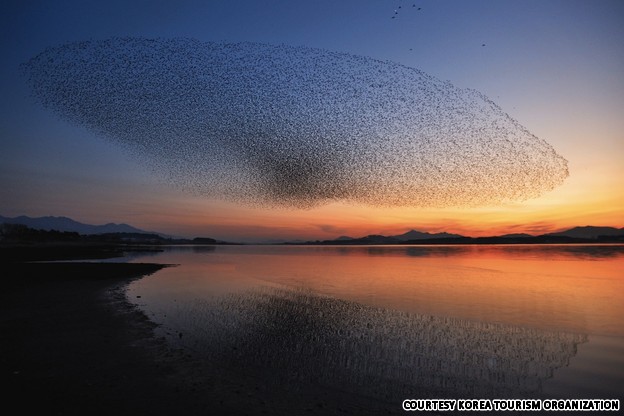|
|
cnn 선정 한국 /cnn 한국 50/ CNN 에서 선정한 한국의 아름다운곳 50 곳 - 2등은 안면도 꽃지해수욕장 As these spectacularly photographic spots show,
if you've only been to Seoul, you're missing out big time
Some 25 million South Koreans -- about half the population -- travel abroad at least once a year, but it’s safe to assume that most haven't seen all the beautiful sights within the country.
1. Seongsan Sunrise Peak (성산일출봉)
 Cue the cinematic music.
Hydrovolcanic eruptions formed this majestic volcanic crater 5,000 years ago on Jeju Island.
A UNESCO world heritage site, the peak is famous for many things, including numerous rare plant species, but is best known for the magnificent sight of the sun rising over it (hence the name). More on CNNGo: How to visit Jeju Island on a dime 2. Ggotji Beach (꽃지 해수욕장)
 Time to visit the grandparents.
Located four kilometers southwest from Anmyeon-eup, this cream-colored beach is the ideal place to go for a drive and watch the sun sink into the ocean between two large rock formations known as the Granny Rock and the Grandpa Rock.
Legend has it that the wife of a base commanding officer in the Shilla Dynasty became the Granny Rock when she died after waiting faithfully for her husband. Seungeon 4 ri, Anmyeon-eup, Taean-gun, Chungcheongnam-do (충남 태안군 안면읍 승언4리)
3. Darangee Village (경상남도 남해 가천 다랭이마을)
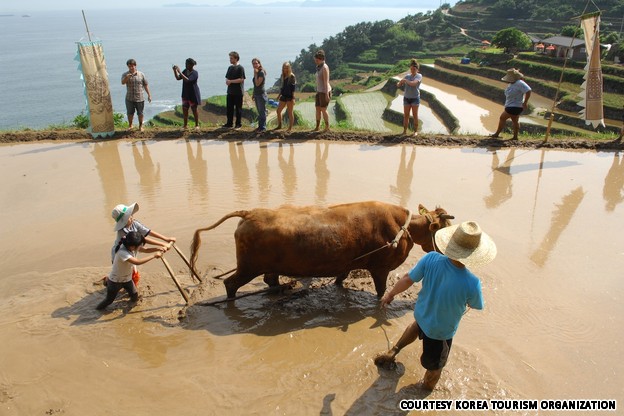 What Korean kids did before video games.
Darangee Village, a small well-preserved village in the southernmost area of west Namhae-gun, features an extraordinary sight of countless tiny fields (over 100 levels) on a steep mountain slope against the open sea. Honghyeon-ri, Nam-myeon, Namhae-gun, Gyeongsangnam-do (경남 남해군 남면 홍현리)
4. Gwang-An Bridge (부산 광안대교)
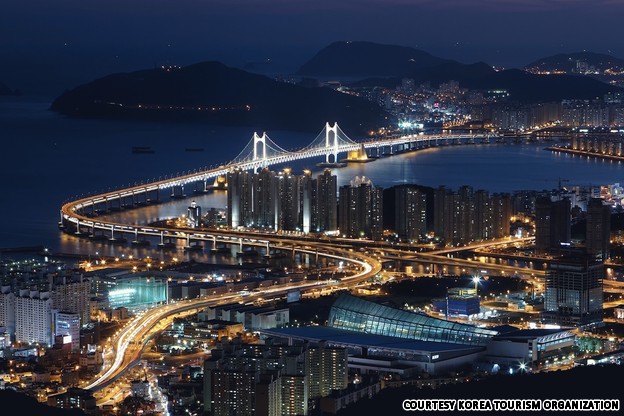 Korea loves its stunning, futuristic bridges.
Also known as the Diamond Bridge, this two-story bridge connects Suyeong-gu and Haeundae-gu and offers an astonishing view of mountains, sandy beaches, hills and city lights. Kwang-An Bridge is not for pedestrians, but anyone can enjoy the spectacular night view of the bridge from afar; its state-of-the-art lighting system allows an exterior lighting of over 100,000 colors. Suyeong-gu, Busan (부산광역시 수영구) 5. Kyeong-Wha Station, Jinhae (진해 경화역)
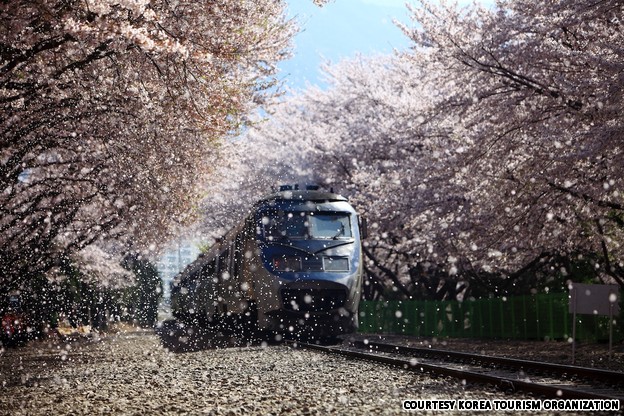 All this scene needs is a soldier and a beautiful girl waiting for him at the station.
This small whistle-stop bustles with tourists and amateur photographers every spring. Cherry blossoms rain down on the train track and countless shutters click madly away as the train approaches the station under the cherry blossom tunnel. The cherry blossom road at Yeojwa stream, (number 17 on this list) is also nearby for those who want more photo-ops. Kyeongwha-dong, Jinhae-gu, Gyeongsangnam-do (경남 창원시 진해구 경화동)
6. Upo Marsh (우포늪)
 Swimming is probably not recommended.
At 2,314 kilometers squared, Upo Marsh is the largest inland wetland in Korea and thrice the size of Yeouido. Formed over 140 million years ago, the marsh is home to 1,500 plants and animals, some of which are endangered species.
7. Jeungdo Salt Farm (전남 신안 증도 염전)
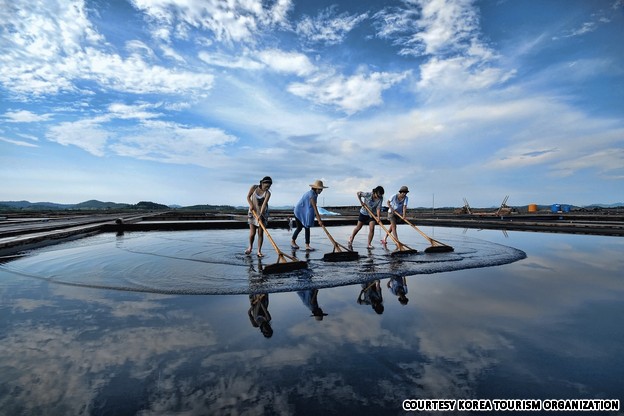 Salt farming in a slow city.
This treasure island (artifacts from the Song Dynasty have actually been found at the bottom of the sea) is famous for its clear seawater, soft beach, and salt farms. 8. Gongryong Ridge, Seorak Mountain (설악산 신선대 공룡능선)
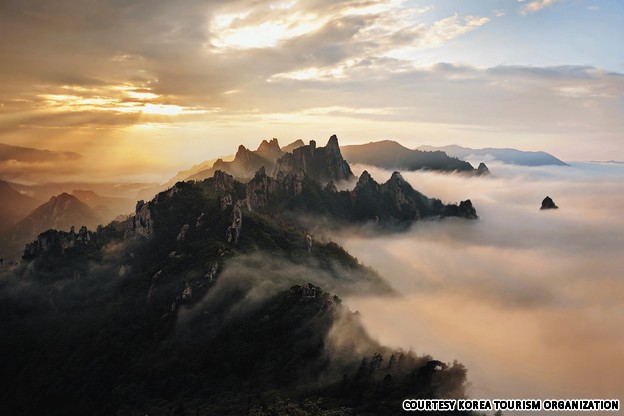 From this distance, it looks like a Stegosaurus, but we can't be sure.
Physical fitness and mountain climbing experience are prerequisites to viewing these curious peaks in the Seorak mountain range. Thought to be shaped like the spine of a dinosaur (hence the name, "Dinosaur Ridge"), this rocky ridge offers spectacular views of both inner and outer Seorak. The climb is no picnic: the peak elevation of Gongryong Ridge, the most popular ridge route in the range, is approximately 1,200 meters. Goseong-gun/Yangyang-gun/Inje-gun, Sokcho-si, Gangwon-do (강원도 속초시 고성군, 양양군, 인제군)
9. Uleung Island Seaside Road (울릉도 해안도로)
 Uleung Island was known as Dagelet to Europeans.
Uleung Island, nicknamed "Mysterious Island", is a popular weekend getaway spot for Seoulites. Curious rock formations, shore cliffs and numerous waterfalls adorn the island’s Seaside Road. Anyone planning to walk or bike their way around Uleung Island should make sure they set aside enough time, as they will inevitably stop countless times to admire the glorious view. Uleung-eup, Uleung-gun, Gyeongsangbuk-do (경북 울릉군 울릉읍)
10. Seopjikoji, Jeju Island (제주도 섭지코지)
 A music video just waiting to be shot.
First-time visitors to Jeju island need to plan their trip wisely, as the Jeju bucket list is long and varied. One of the musts on the list is Seopjikoji, a promontory on the coast famous for its serenity and romance. Yellow rape blossoms fill the field in the spring, creating a colorful contrast with the red soil and cerulean sky. The best photographs of Sungsan Sunrise Peak (the first item on this list) can be taken here at Seopjikoji. The scenery of Seopjikoji has also been captured by several Korean films and dramas, including "All In," one of the first Hallyu dramas starring Lee Byung-hun and Song Hye-kyo. 261 Seopjikoji-ro, Sungsan-eup, Seogwipo-si, Jeju Special Self-Governing Province (제주특별자치도 서귀포시 성산읍 섭지코지로 261) More on CNNGO: The pensive moods of Jeju Island
11. Bomun Pavilion, Gyeongju (경주 보문정)
 A pavilion for all seasons.
Gyeongju, an ancient capital of the Shilla Dynasty, boasts the nickname "a museum with no walls." Bomun Pavilion, a small wooden gazebo standing over a quiet duck pond, is a great spot to experience Korea’s spring; the cherry blossoms fluttering over the pond provide an exquisite sight. In fact, it's the perfect place to view all of Korea's markedly different seasons: summer's lush green leaves, fall's scarlet and mustard foliage, and winter's blankets of snow. Bodeok-dong, Gyeongju-si, Gyeongsangbuk-do (경북 경주시 보덕동)
12. Udo (우도)
The Korean way of making a wish.
Visitors can hike on Olle road, or opt for a scooter ride along the shore, a submarine excursion or sea fishing. Just don't forget the sunblock. Udo-myeon, Jeju-si, Jeju Special Self-Governing Province (제주특별자치도 제주시 우도면)
13. Haeinsa Temple, Hapcheon (합천 해인사)
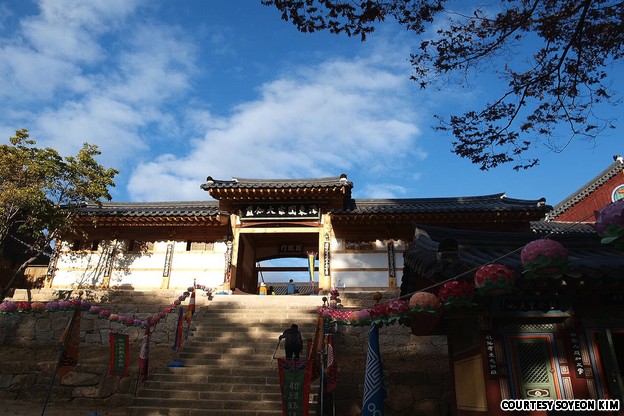 Haeinsa is one of the three Jewel Temples in Korea.
The world's oldest intact Buddhist canon, the Tripitaka Koreana, is carefully housed in the 1,200-year-old Haeinsa Temple. The temple's other landmarks include the oldest wooden Buddha statue in Korea (the Haeinsa Vairocana) and a UNESCO world heritage Janggyeong Panjeon ( a "storage hall of Buddhist Sutras"). 10 Chiin-ri, Gaya-myeon, Hapcheon-gun, Gyeongsangnam-do (경남 합천군 가야면 치인리 10번지)
14. Chunwang Peak, Jiri Mountain (지리산 천왕봉)
 Where to look down on clouds.
At 1,915 meters, Chunwang Peak on Jiri Mountain is the second highest peak in South Korea and the beloved conquest of many a Korean mountain climber. The national park on Jiri Mountain stretches over five cities and three provinces, and is home to quietly dazzling flora and fauna as well as seven national treasures and 26 treasures. Many tread the trail to Chunwang Peak to watch the sun rise, some simply to enjoy the view from the top, and others for the pleasure of breathing in the crisp, clean mountain air and drinking the brain freeze-inducing spring water of Chunwang Spring, which is located just 300 meters below Chunwang Peak. Samjang-myeon/Sicheon-myeon, Sancheong-gun, Gyeongsangnam-do (경남 산청군 시천면, 삼장면)
15. Juknokwon, Damyang (담양 죽녹원)
Unfortunately Korea's all out of pandas.
Eight trails around the thicket offer eight different themes to saunter through. If you look carefully between the bamboo plants, you can spot the green tea shoots that grow from the dew that drips off the bamboo leaves, known as Jukro tea. The Juknokwon observatory in the middle of the thicket occasionally hosts Jukro tea tasting events. Hyanggyo-ri, Damyang-eup, Damyang-gun, Jeollanam-do (전남 담양군 담양읍 향교리)
16. Naganeupseong Folk Village, Suncheon (순천 낙안읍성 민속마을)
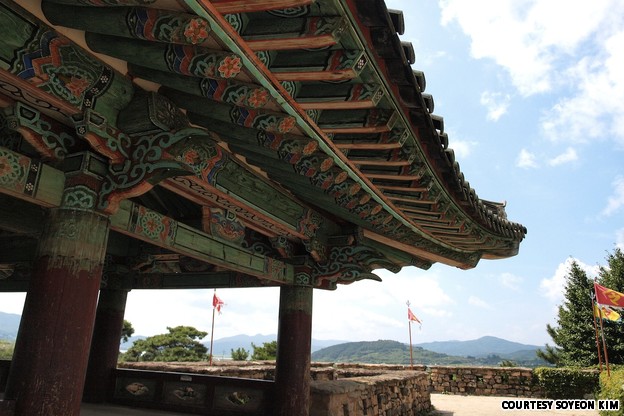 We wonder how many people it took to color a single roof.
Straw-roofed houses, government offices, guesthouses and a castle, all from the Chosun Dynasty, remain perfectly preserved in their original forms in this 22.6 kilometer-squared historical site. No, it’s not an exterior set of a historical drama, people actually live in those houses and better yet, they offer overnight homestays. Choongmin-gil, Nagan-myeon, Suncheon-si, Jeollanam-do (전라남도 순천시 낙안면 충민길 30) 17. Yeojwa Stream (경상남도 진해 여좌천 벚꽃길)
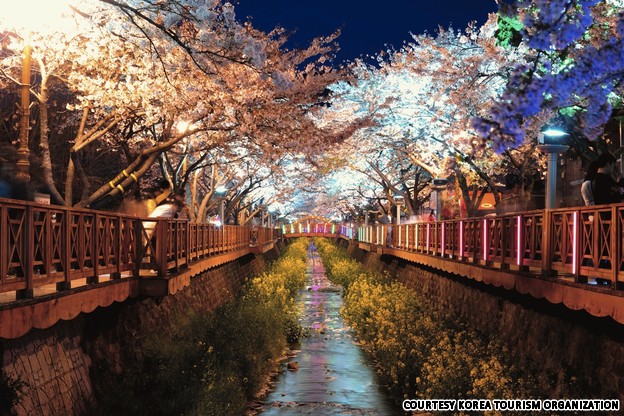 This spot is the spring equivalent of mistletoe.
The fifth item on this list already touched on the festival of cherry blossoms in Jinhae, but the cherry blossom road at Yeojwa Stream is so strikingly beautiful that it deserves another mention (and another photo). Lovers visit this site to cross the "Romance Bridge", which has been used as a shooting location for "Romance," a drama starring Kim Ha-nul and Kim Jae-won. Bloggers say that these romantic blossoms can be most appreciated at night, when there are fewer tourists and the pale pink flowers glow against the dark sky. Yeojwa-dong, Jinhae-gu, Changwon-si, Gyeongsangnam-do (경상남도 창원시 진해구 여좌동)
18. Boseong Green Tea Field (보성 녹차밭)
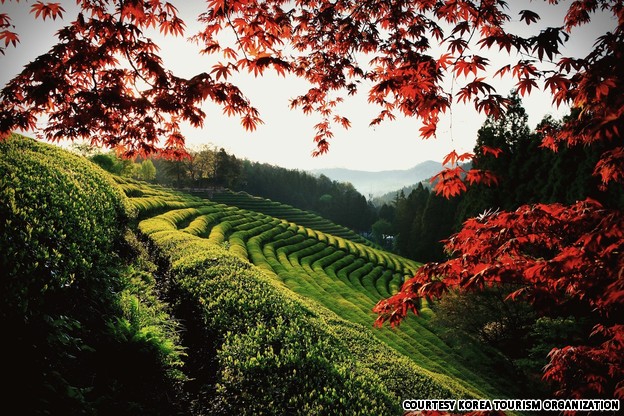 The most caffeinated field in the country.
Approximately 40 percent of Korea's tea is produced in the rolling fields of Boseong, which has also provided the backdrop of many Korean dramas and films. Yes, green tea-related specialties (fresh green tea ice cream and green tea pork belly) are tasty treats, but the spectacular view of the seemingly endless tea fields is the real reason so many visitors stop by Boseong. A green tea festival is held every May while in the winter, the fields are decorated with tiny light bulbs. Bongsan-ri, Boseong-eup, Boseong-gun, Jeollanam-do (전라남도 보성군 보성읍 봉산리)
19. Bulguksa Temple (경주 불국사)
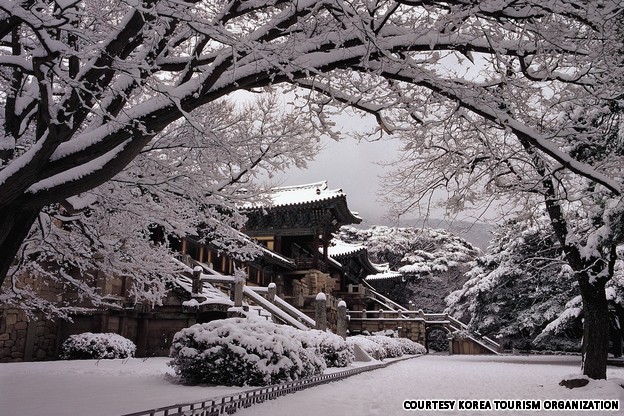 Where to bookmark your history books.
This UNESCO-listed site is perhaps the most famous historic site in Korea. Two granite pagodas on either sides of the temple, Dabotap and Seokgatap, as well as Seokguram, a man-made grotto just above the temple, add to the splendid grandeur of this 1,500-year-old home of many important relics. 15-1 Jinhyeon-dong, Gyeongju-si, Gyeongsangbuk-do (경상북도 경주시 진현동 15-1)
20. Daegwallyeong Ranch (대관령 양떼목장)
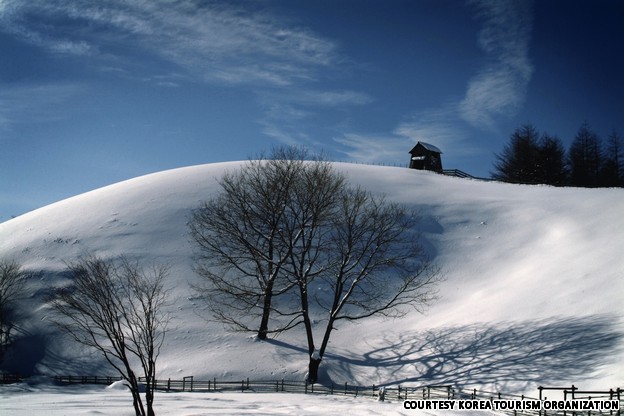 The lamb are there, you're just not looking closely.
This only sheep ranch in Korea doubles as a natural sledge park in winter. The dreaminess of the view is as heady as the mountain air. Meat-lovers should stop by the restaurants in the ranch village for a taste of the highest grade lamb. 14-104 Hoenggye 3 ri, Doam-myeon(Daegwallyeong-myeon), Pyeongchang-gun, Gangwon-do (강원 평창군 도암면 횡계3리 (대관령면 횡계3리) 14-104번지)
21. Cheongdo Bull Fighting Festival (청도 소싸움 축제)
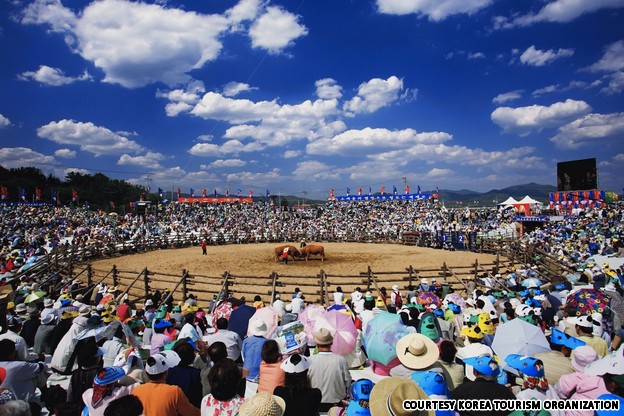 Just don't wear red.
As the biggest bull fighting festival in Korea, Cheongdo Bull Fighting Festival attracts around half a million people every year. In addition to the big matches of 130 fighting bulls, there are art contests, cow-play exorcisms, rodeo experience, and even magic shows to entertain the crowd. If the sights are a bit too violent for your taste, check out other Cheongdo attractions such as the Nakdae Waterfall and Unmun Temple. Cheongdo-gun, Gyeongsangbuk-do (경상북도 청도군)
22. Hyeopjae Beach, Jeju Island (제주도 협재 해수욕장)
 We think this beach is one of the main reasons Jeju Island made it unto the seven new wonders list.
This white sandy beach is perfect for families with its shallow water (average depth of 1.2 meters), nearby amenities, and camping in the pine forest surrounding the beach. Hyeopjae is also particularly known for its delicious abalones and conches, served fresh in the seafood restaurants dotting the beach. 2497-1 Hyeopjae-ri, Hallim-eup, Jeji-si, Jeju Speicial Self-Governing Province (제주특별자치도 제주시 한림읍 협재리 2497-1번지)
23. Anapji (Anap Pond) (경주 안압지)
 There are lotus flowers under there somewhere.
This man-made pond was created during the Shilla Dynasty approximately 1,500 years ago. Three buildings stand on three artificial islands while patches of lotus flowers frame the pond. Gorgeous exterior lighting that go on after sunset create a magical night view. 26 Inwang-dong, Gyeongju-si, Gyeongsangbuk-do (경상북도 경주시 인왕동 26)
24. Seryang-Je (세량제)
 All this scene is missing is a fairy.
Seryang-Je, a reservoir built in 1969 in Hwasun, is another famous spot for both professional and amateur photographers for its ethereal mist and reflections of colorful blossoms and leaves. Seryang-ri, Hwasun-eup, Hwasun-gun, Jeollanam-do (전라남도 화순군 화순읍 세량리)
25. Kwanghan Pavilion (광한루)
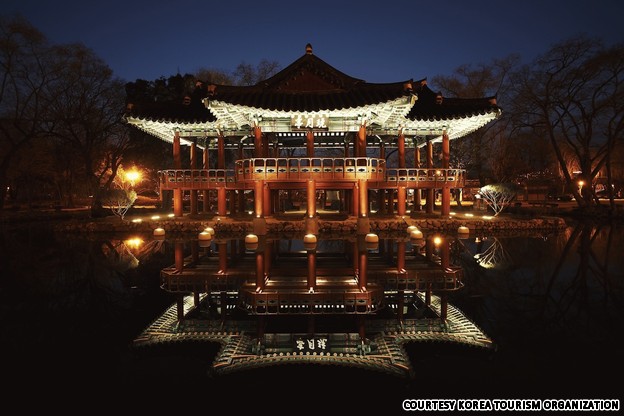 This picture probably would work upside-down as well.
Kwanghan Pavilion is the setting of Chunhyangjeon, one of Korea's most famous folk tales. Chunhyang, the young, beautiful daughter of a gisaeng (Korean geisha), and Mongryong, the handsome son of the local governor, first met and fell in love in this beautifully designed pavilion, which was designated a treasure in 1963. 77-1 Cheongeo-dong, Namwon-si, Jeollabuk-do (전북 남원시 천거동 77-1)
26. Seomjin River Train Village (섬진강 기차마을)
 Where it's safe to walk along the tracks.
Kudos to the Gokseong district office, which has managed to create a lovely tourist attraction out of abandoned railroads. A brief steam train ride (they don’t make ’em like this anymore, literally) is available for tourists, who can also enjoy a bike hike on a trail bike or a romantic walk beside the train track. 770-5 Oji-ri, Ogok-myeon, Gokseong-gun, Jeollanam-do (전라남도 곡성군 오곡면 오지리 770-5)
27. Cheongsando (청산도)
 We prefer the word "leisurely."
For a small country road, Cheongsando marks a lot of "firsts" -- it is the world’s first "Slow Road" in Asia’s first "Slow City". one’s pace naturally slackens to fall in with the pace of the rest of the island. bordered by simple stone walls. Cheongsan-myeon, Wando-gun, Jeollanam-do (전라남도 완도군 청산면)
28. Halla Mountain (한라산)
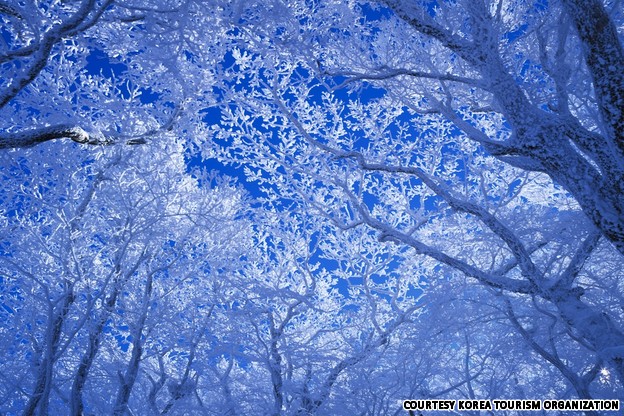 What Narnian skies must have looked like under the grip of the White Witch.
This fairy-tale sight of snowflakes and icicles covering tree branches on Halla Mountain were the inspiration for the Halla Snow Festival that was held late January/early February every year. Unfortunately, the festival was halted a few years ago because whenever they set a date it would rain and people would get mad. But the snow-covered trees are still there, and you are welcome to go sledding, snow rafting and ice sliding on your own. Halla Mountain, Jeju Special Self-Governing Province (제주특별자치도 한라산)
29. Terraced Fields, Hamyang (함양 다락논)
 Who knew there were so many shades of green?
This small village at the foot of Jiri Mountain displays a curious sight of terraced rice paddies. while in autumn the paddies glow with golden grains. Macheon-myeon, Hamyang-gun, Gyeongsangnam-do (경남 함양군 마천면)
30. Nuri Peace Park (임진각 평화누리공원)
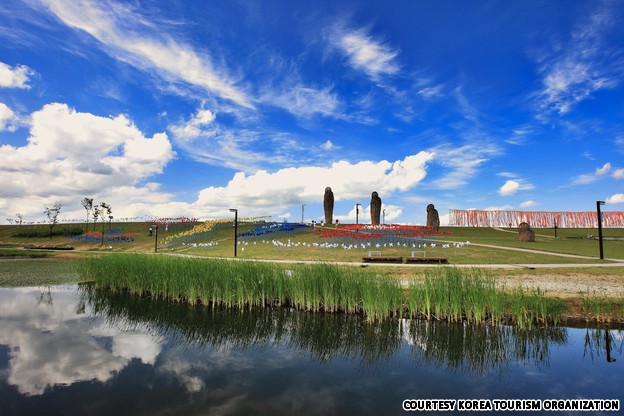 Primary colors in full bloom.
This artistic park located in Paju embodies South Koreans’ yearning and longing for peace in the Korean peninsula. 618-13 Majeong-ri, Munsan-eup, Paju-si, Gyeonggi-do (경기도 파주시 문산읍 마정리 618-13)
31. Silk Fall, Jiri Mountain (지리산 뱀사골 실비단폭포)
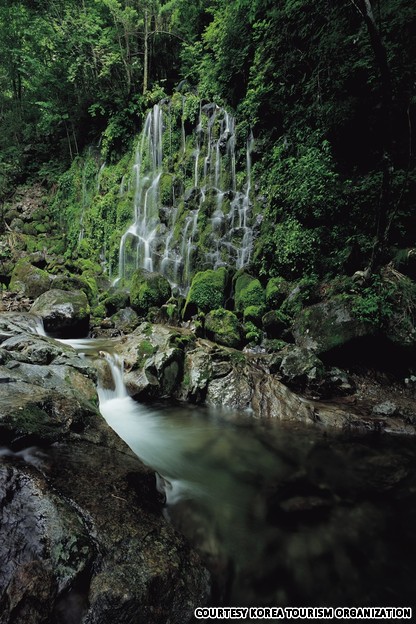 This waterfall is camera-shy.
This mossy waterfall is in a now-restricted area of Jiri Mountain, which means a ₩500,000 fine for anyone caught venturing near here. Baemsa-Valley, Jiri Mountain, Namwon-si, Jeollabuk-do (전북 남원시 지리산 뱀사골) 32. Young-san River (영산강)
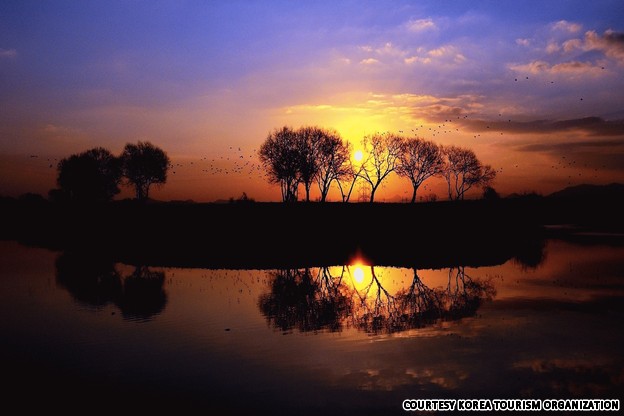 One of the four major rivers (4대강) in Korea.
Among the many beautiful river views in Korea, those from the Young-san River rank among the top and give those from Han River some serious competition. Damyang to Mokpo. Yongso-ri, Yong-myeon, Damyang-gun, Jeollanam-do (전남 담양군 용면 용소리)
33. Poppy Garden, Simhak Mountain, Paju (파주 심학산 꽃밭)
 Running around with flowers in your hair seems like the logical thing to do here.
The poppy-dotted scenery at Simhak Mountain looks like it's straight out of a Claude Monet painting. the local town hosts a Poppy Festival here every year around June. Simhak Mountain, Paju-si, Gyeonggi-do (경기도 파주시 심학산)
34. Royal Azalea Festival, Hwangmae Mountain (황매산 철쭉축제)
 The color of royalty.
At 1,108 meters, Hwangmae Mountain is the highest peak in the Sobaek mountain range, and is covered by royal azalea blossoms every spring. 1 Mountain, Beoppyeong-ri, Chahwang-myeon, Sancheong-gun, Gyeongsangnam-do (경남 산청군 차황면 법평리 산1번지)
35. Sin-Reuk Temple, Yeo Ju (여주 신륵사)
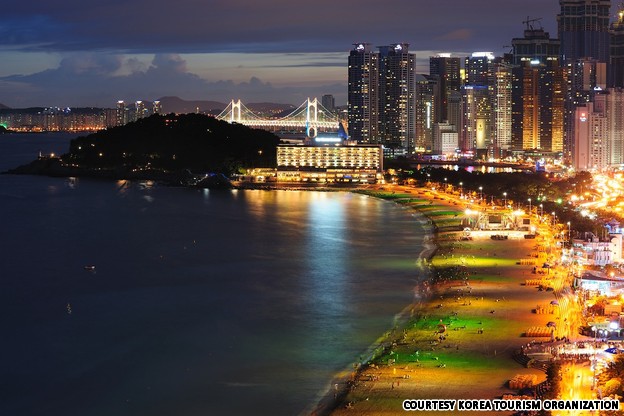 Had enough of breathtaking views? Go shopping at the Yeoju outlets nearby.
This old riverside temple is relatively unknown to the public and features quite a few treasures including stone pagodas, a stone bell and a grove of zelkova trees. 282 Cheonsong-ri, Yeoju-eup, Yeoju-gun, Gyeonggi-do (경기도 여주군 여주읍 천송리 282)
36. Daedun Mountain Suspension Bridge (대둔산 구름다리)
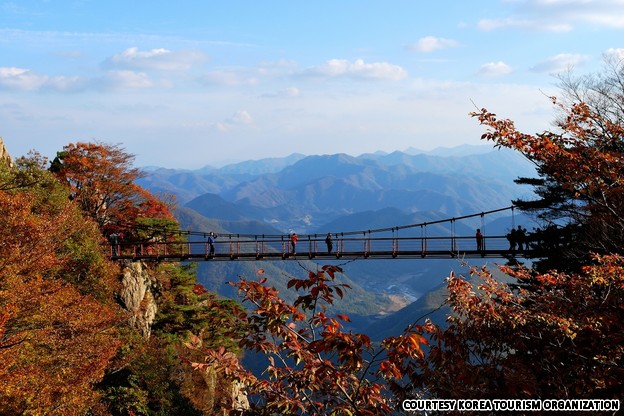 "Whatever you do, don't look down."
Daedun Mountain is famous for its bright autumn colors and its 81-meter-high Geumgang Suspension Bridge. 37. Haeundae Beach (해운대 해수욕장)
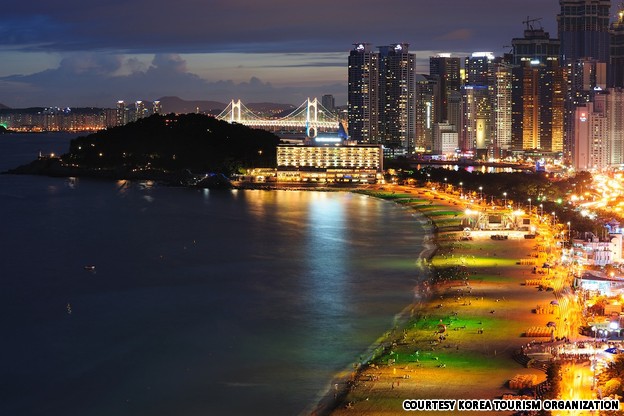 Unfortunately, you'll almost never find the beach as empty as it is in this photo.
Hundreds of thousands frequent to this renowned beach every summer, but summer is not the only season you can see some flesh at Haeundae -- the Polar Bear Festival is held every January, when contestants leap in the cold ocean screaming and laughing. Woo 1-dong,Joong-dong, Haeundae-gu, Busan (부산 해운대구 우1동 , 중동) More on CNNGo: Pocket guide to Busan: 11 best eats and sights
38. Yongam Temple (옥천 용암사)
 This sight brought tears to one prince's eyes.
Originally built in 552, this temple takes its name from a nearby rock that was supposed to have been shaped like a dragon but was destroyed along with most of the temple during the Japanese occupation. Samcheong-ri, Okcheon-eup, Okcheon-gun, Chungcheongbuk-do (충북 옥천군 옥천읍 삼청리)
39. Snow in Taebaek Mountain (태백산 설경)
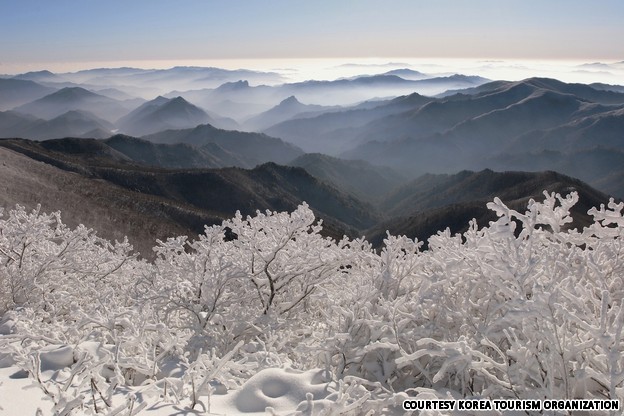 Mountain country.
Gangwon province is famous for catastrophically heavy snows in the winter. The 18th Taebaek Snow Festival will take place January 27-February 5 this year and will feature sledding, snow rafting, ice slides and snowball fights. For more information, click here. Mungok-dong, Taebaek-si, Gangwon-do (강원도 태백시 문곡동) More on CNNGo: 7 best ski and snowboard resorts in Korea 40. Yang Dong Traditional Village (양동 한옥마을)
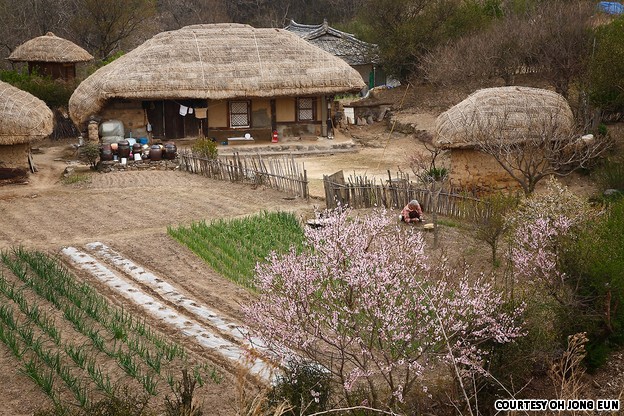 The hottest brunch spot in Yangdong Village.
The nature and culture of this village remains the same as it was during the Chosun Dynasty.
One of the most recent additions to the UNESCO world heritage list, the village has featured famous guests such as Prince Charles and Ban Ki-Moon. Yangdong-ri, Gangdong-myeon, Gyeongju-si, Gyeongsangbuk-do (경북 경주시 강동면 양동리)
41. Nami Island (남이섬)
Fans of "Winter Sonata" will recognize this famous road.
Despite the fact that Nami Island is a place of historical interest (the island is named after Minister Nami, a Minister of War during the Chosun Dynasty), most visitors come to stroll down the famous Metasequoia road or see where Bae Yong-joon and Choi Ji-woo stood or sat during the filming for the original Hallyu drama "Winter Sonata." Bangha-ri, Namsan-myeoon, Chuncheon-si, Gangwon-do (강원도 춘천시 남산면 방하리)
42. Suncheon Bay (순천만)
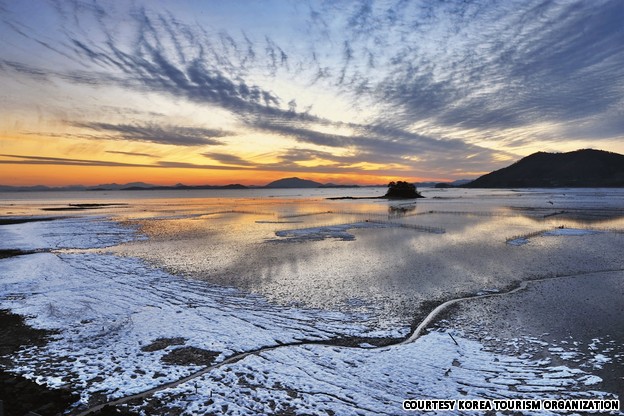 The perfect respite from city life.
One of the biggest coastal marshes in the world, Suncheon Bay is home to countless plants and marine life and features the biggest field of reeds (5.4 kilometers squared) in Korea. 162-2 Daedae-dong, Suncheon-si, Jeollanam-do (전라남도 순천시 대대동 162-2) 43. Inje Smelts Festival (인제 빙어축제)
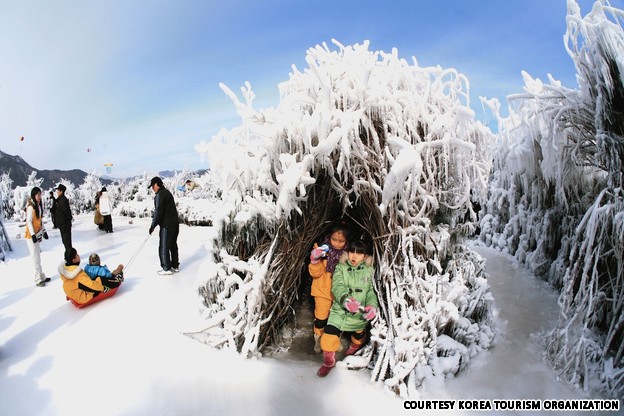 How to catch some rest at an ice fishing festival.
The Inje Smelts Festival takes place on Soyang lake every winter and offers families and couples (and the occasional single visitor) some major fun on ice. january 28 - February 5; www.injefestival.co.kr Soyang Lake, Inje-gun, Gangwon-do (강원도 인제군 소양호)
44. Ulsan Rock, Seorak Mountain (울산바위)
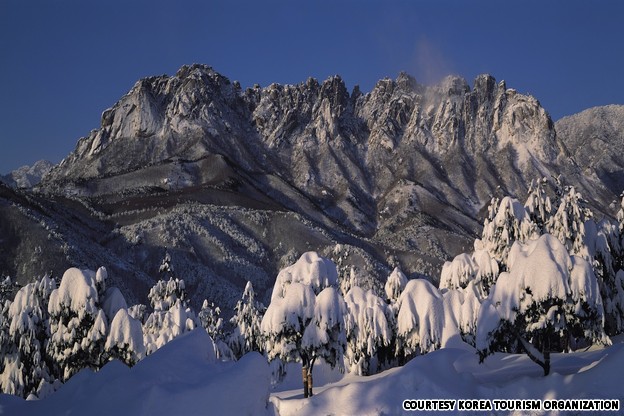 Who needs carved faces when you've got legends?
This six-peaked rocky mountain has five urn-shaped holes at the top and is named "Crying Mountain," due to legends and ancient records that claim the rocks on the mountain cry just before a big wind is about to blow. Another legend behind the mountain's name says that a rock was wandering around looking for Geumgangsan but settled in Seoraksan when it couldn't find it, and became the Ulsan rock. Seorak National Park, Seorak-dong, Sokcho-si, Gangwon-do (강원 속초시 설악동 설악산국립공원)
45. Bangwhasuryujeong, Suwon Hwa Seong (화성 방화수류정)
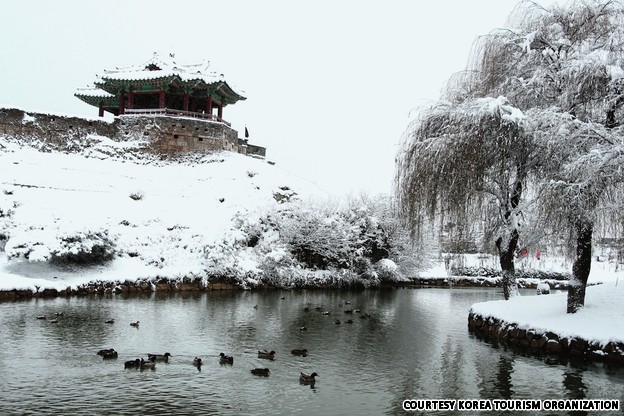 A literal setting for poetry.
Bangwhasuryujeong is one of four polygonal pavilions in Hwa Seong. Paldal-gu, Suwon-si, Gyeonggi-do (경기도 수원시 팔달구)
46. Namdae Stream, Muju (무주 남대천 섶다리)
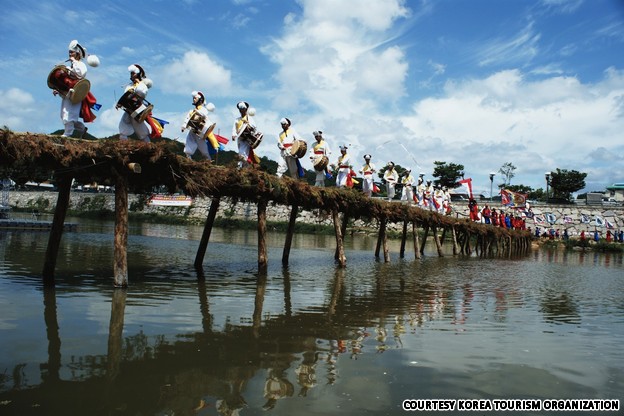 Headbanging, Korean style.
Traditionally, a seop bridge -- a temporary bridge fashioned out of logs, mud, and pine branches -- was built to let the villagers cross Namdae River from early winter until the summer, when heavy rains would wash the bridge away. Namdae Stream, Muju-eup, Muju-gun, Jeollabuk-do (전라북도 무주군 무주읍 남대천)
47. Donglim Reservoir, Gochang (고창 동림저수지)
Approximately four fifths of the migratory birds that can be seen every year at the reservoir are teals.
Every year, more than 200,000 spectacled teals (the color takes its name from the bird) fly about in an orderly manner above this beautiful reservoir, which was voted "Kingdom of migratory birds" in 2004 in a national survey. Heungduk-myeon/Sungnae-myeon, Gochang-gun, Jeollabuk-do (전북 고창군 흥덕면/성내면)
48. The Garden of Morning Calm (아침고요수목원) A new kind of horticulture lecture hall.
The Garden of Morning Calm is a beautifully designed and balanced arboretum in Gapyeong, run by a professor of horticulture. 255 Mountain Haenghyeon-ri, Sang-myeon, Gapyeong-gun, Gyeonggi-do (경기도 가평군 상면 행현리 산 255번지)
49. Chok-suk Pavilion (촉석루)
 Where a dip in the river turned dramatic.
This beautiful, historical pavilion overlooking Nam River is most famous as the place where Nongae, the concubine of a government official in the Chosun Dynasty, jumped into the river with a Japanese general after the castle of Jinju fell into Japan’s hands. they won’t be telling your story in the same way. 573-1 Bonsung-dong, Jinju-si, Kyeongsangnam-do (경상남도 진주시 본성동 573-1)
50. Samkwang Temple (삼광사 연등축제)
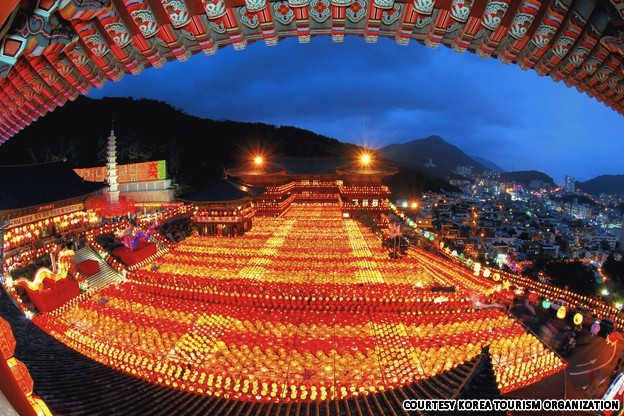 The festival of lights is not just for Buddhists.
Every year, around Buddha’s birthday, the biggest Lotus Lantern Festival in Busan is held at Samkwang Temple. More on CNNGo: And the most beautiful village in Korea is ...
계속해서...사이버서산 서해안여행에서 선정한 한국의 서해안 서북부 아름다운곳 50 선이 소개 됩니다. |


|



